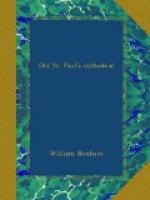Inside this area ran a cloister along the north side, turning a short distance southwards at the east end. This cloister was rebuilt by Dean More (1407-1421) round an enclosure which was a burial ground for clerics and men of mark in the City. The cloister was decorated by the series of paintings commonly known as the Dance of Death, such as may still be seen in the Cathedral of Basel, and in other places. Verses were appended to each picture, which were translated by Lydgate, the monk of Bury, and writer of poems on classical and religious subjects. Over the eastern side of the cloister was the library, a very fine one, but it perished in the Great Fire. The name “Pardon” applied to burial grounds, was not uncommon, apparently. The victims of the Black Death, in 1348, were buried in a piece of ground on the site of the Charter House, and this ground was known as Pardon Churchyard; and in the register books of St. Helen’s, Bishopsgate, there are two entries of City magnates buried at different times by “the Pardon Door.” Does it indicate that these particular burial grounds were bought with money paid for indulgences or expiations?
In the middle of the Pardon Churchyard of St. Paul’s was a chapel of rich ornament, built by “Gilbert Becket, portgrave and principal magistrate in this City in the reign of King Stephen.” He was the great Archbishop’s father. The monuments in it and the surrounding churchyard are said to have rivalled in beauty those inside the cathedral. How this cloister and chapel fared, we shall see presently.
[Illustration: A FUNERAL PROCESSION. From a MS. of the Hours of the Virgin. Fifteenth Century. British Museum, 27697.]




